ACCT20074 Contemporary Accounting Theory: Conceptual Framework Report
VerifiedAdded on 2023/03/30
|18
|3889
|293
Report
AI Summary
This report delves into contemporary accounting theory, exploring the evolution and application of conceptual frameworks in financial reporting across the USA, UK, Australia, and globally under the IASB. It examines the history and development of these frameworks, along with the concerns of the Australian accounting profession and academics regarding their quality, benefits, and limitations. The report analyzes how the conceptual framework is applied by QBE Insurance Group Limited. Furthermore, it compares sustainability reporting guidelines and the International Integrated Reporting Framework, evaluating the rigor of conventional accounting in the context of sustainability and integrated reports. The applicability of accounting theories to explain the contents of sustainability and integrated reports is also discussed, alongside a detailed analysis of the components of an integrated report and their disclosure by a selected South African company. Finally, it compares QBE Insurance Group Limited's reporting practices with those of MMI Holdings Limited, offering a comprehensive overview of corporate external reporting practices.
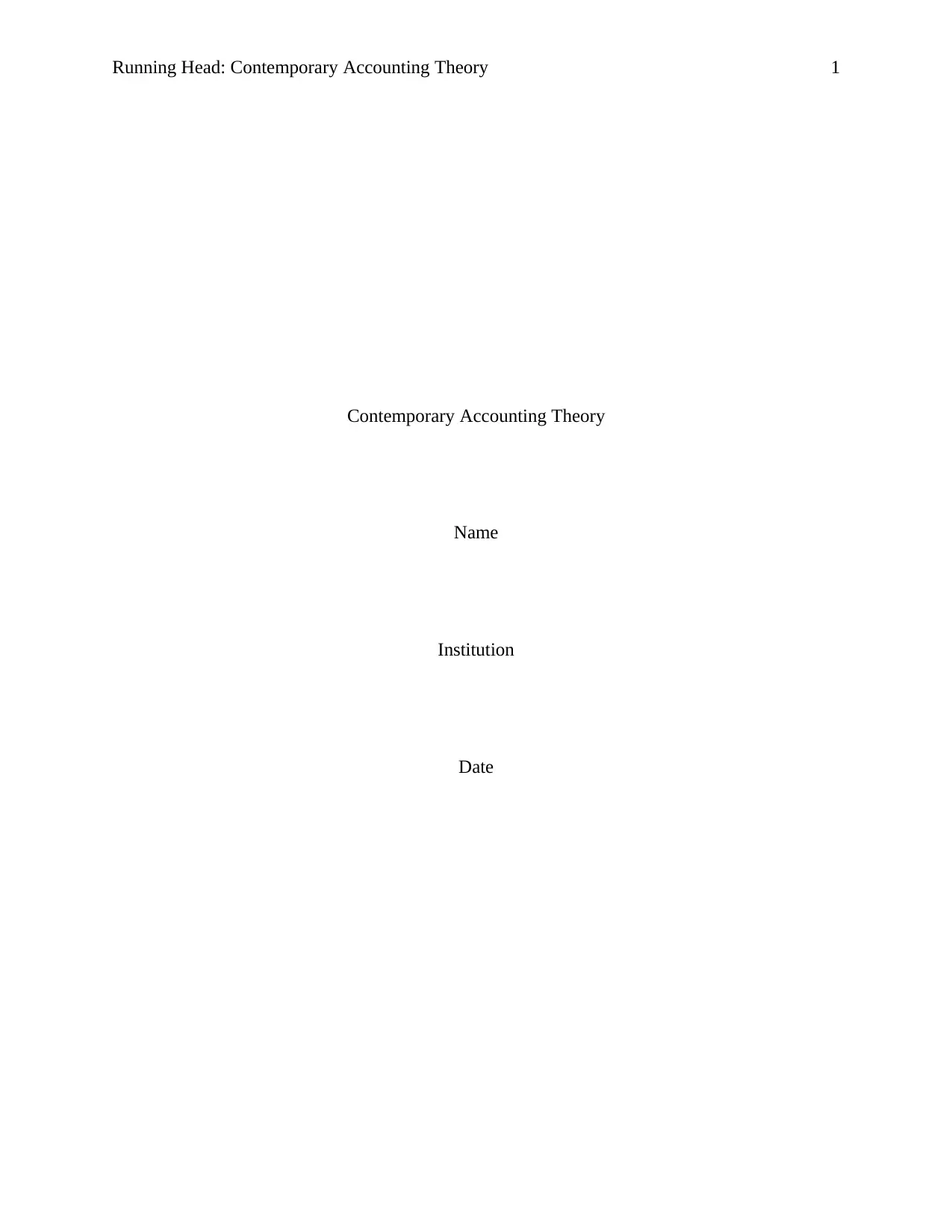
Running Head: Contemporary Accounting Theory 1
Contemporary Accounting Theory
Name
Institution
Date
Contemporary Accounting Theory
Name
Institution
Date
Paraphrase This Document
Need a fresh take? Get an instant paraphrase of this document with our AI Paraphraser
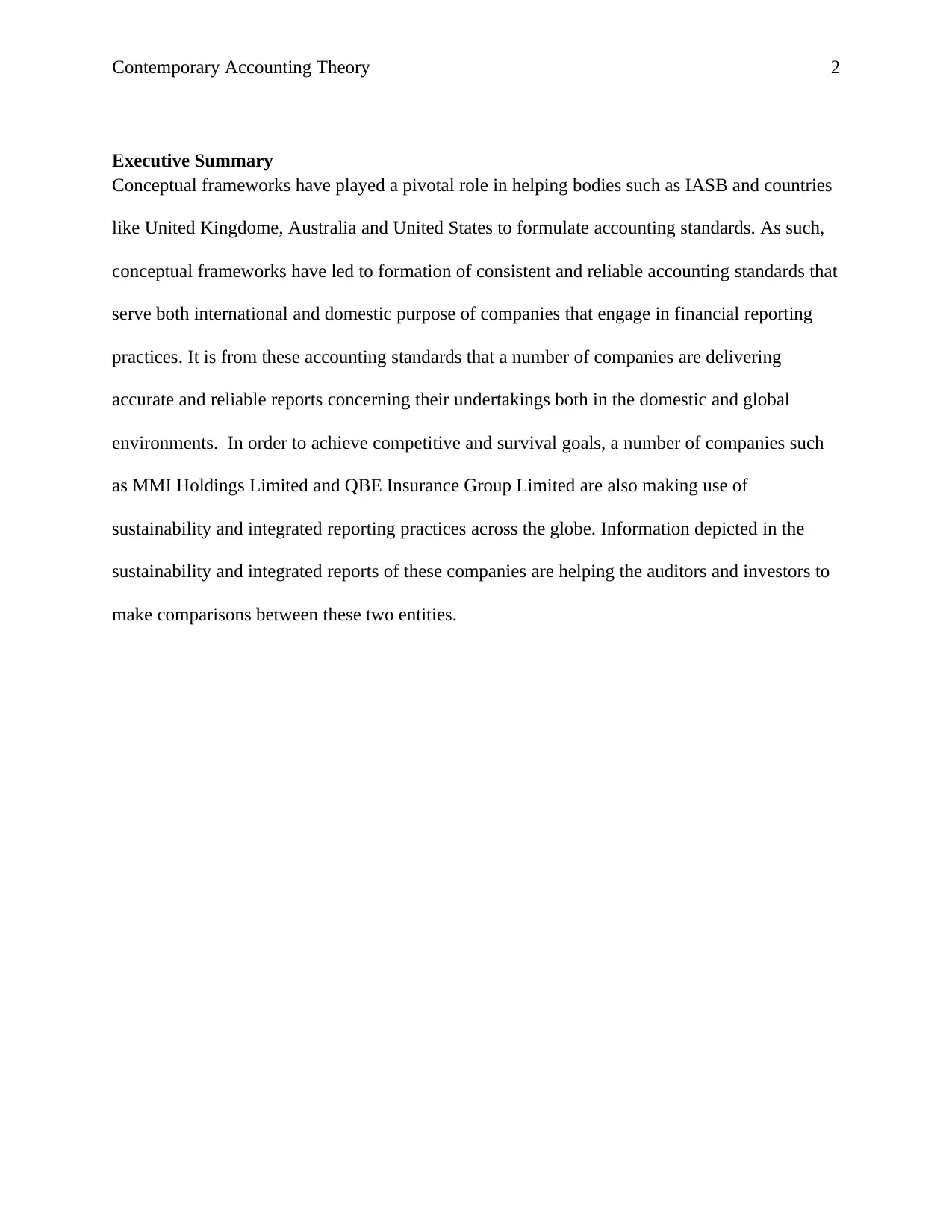
Contemporary Accounting Theory 2
Executive Summary
Conceptual frameworks have played a pivotal role in helping bodies such as IASB and countries
like United Kingdome, Australia and United States to formulate accounting standards. As such,
conceptual frameworks have led to formation of consistent and reliable accounting standards that
serve both international and domestic purpose of companies that engage in financial reporting
practices. It is from these accounting standards that a number of companies are delivering
accurate and reliable reports concerning their undertakings both in the domestic and global
environments. In order to achieve competitive and survival goals, a number of companies such
as MMI Holdings Limited and QBE Insurance Group Limited are also making use of
sustainability and integrated reporting practices across the globe. Information depicted in the
sustainability and integrated reports of these companies are helping the auditors and investors to
make comparisons between these two entities.
Executive Summary
Conceptual frameworks have played a pivotal role in helping bodies such as IASB and countries
like United Kingdome, Australia and United States to formulate accounting standards. As such,
conceptual frameworks have led to formation of consistent and reliable accounting standards that
serve both international and domestic purpose of companies that engage in financial reporting
practices. It is from these accounting standards that a number of companies are delivering
accurate and reliable reports concerning their undertakings both in the domestic and global
environments. In order to achieve competitive and survival goals, a number of companies such
as MMI Holdings Limited and QBE Insurance Group Limited are also making use of
sustainability and integrated reporting practices across the globe. Information depicted in the
sustainability and integrated reports of these companies are helping the auditors and investors to
make comparisons between these two entities.
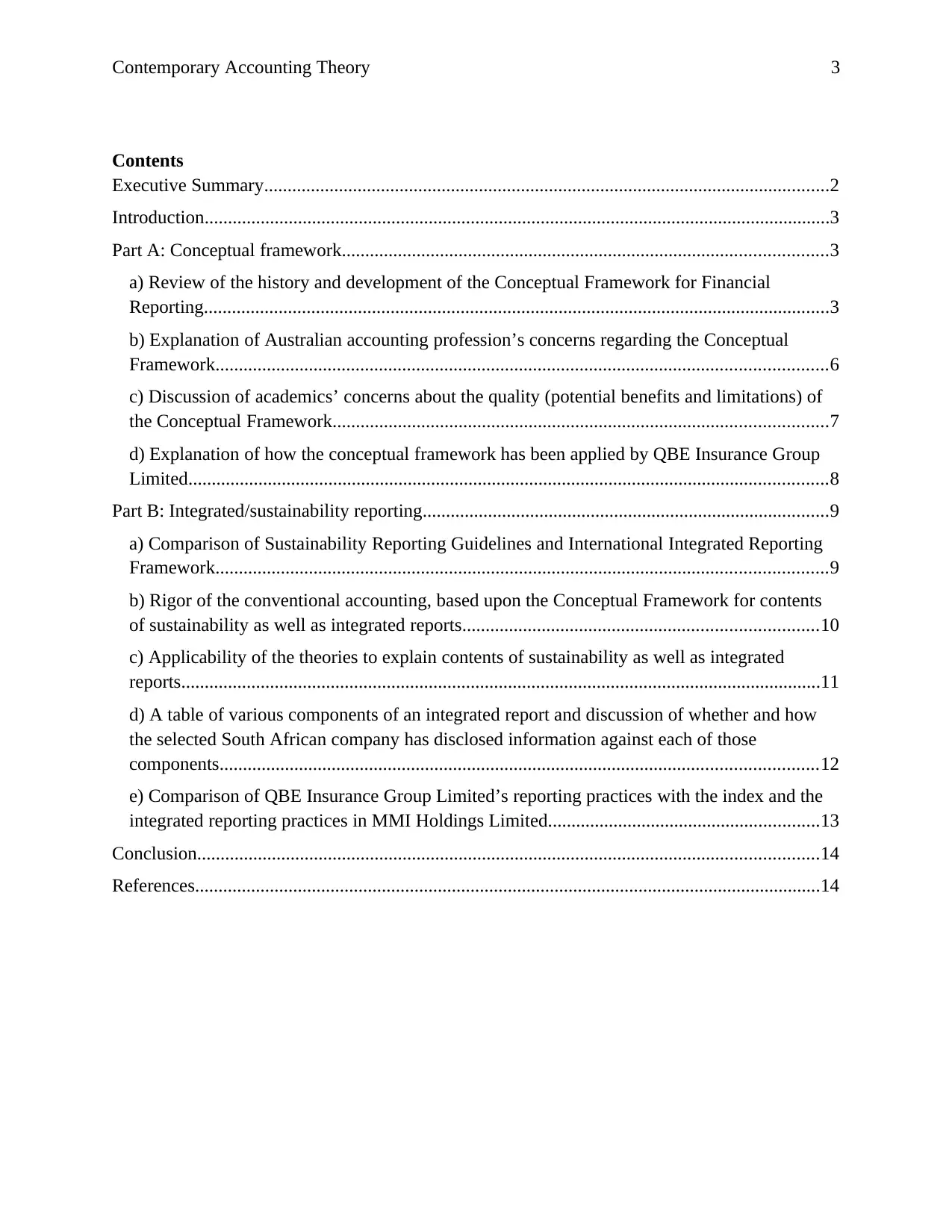
Contemporary Accounting Theory 3
Contents
Executive Summary.........................................................................................................................2
Introduction......................................................................................................................................3
Part A: Conceptual framework........................................................................................................3
a) Review of the history and development of the Conceptual Framework for Financial
Reporting......................................................................................................................................3
b) Explanation of Australian accounting profession’s concerns regarding the Conceptual
Framework...................................................................................................................................6
c) Discussion of academics’ concerns about the quality (potential benefits and limitations) of
the Conceptual Framework..........................................................................................................7
d) Explanation of how the conceptual framework has been applied by QBE Insurance Group
Limited.........................................................................................................................................8
Part B: Integrated/sustainability reporting.......................................................................................9
a) Comparison of Sustainability Reporting Guidelines and International Integrated Reporting
Framework...................................................................................................................................9
b) Rigor of the conventional accounting, based upon the Conceptual Framework for contents
of sustainability as well as integrated reports............................................................................10
c) Applicability of the theories to explain contents of sustainability as well as integrated
reports.........................................................................................................................................11
d) A table of various components of an integrated report and discussion of whether and how
the selected South African company has disclosed information against each of those
components................................................................................................................................12
e) Comparison of QBE Insurance Group Limited’s reporting practices with the index and the
integrated reporting practices in MMI Holdings Limited..........................................................13
Conclusion.....................................................................................................................................14
References......................................................................................................................................14
Contents
Executive Summary.........................................................................................................................2
Introduction......................................................................................................................................3
Part A: Conceptual framework........................................................................................................3
a) Review of the history and development of the Conceptual Framework for Financial
Reporting......................................................................................................................................3
b) Explanation of Australian accounting profession’s concerns regarding the Conceptual
Framework...................................................................................................................................6
c) Discussion of academics’ concerns about the quality (potential benefits and limitations) of
the Conceptual Framework..........................................................................................................7
d) Explanation of how the conceptual framework has been applied by QBE Insurance Group
Limited.........................................................................................................................................8
Part B: Integrated/sustainability reporting.......................................................................................9
a) Comparison of Sustainability Reporting Guidelines and International Integrated Reporting
Framework...................................................................................................................................9
b) Rigor of the conventional accounting, based upon the Conceptual Framework for contents
of sustainability as well as integrated reports............................................................................10
c) Applicability of the theories to explain contents of sustainability as well as integrated
reports.........................................................................................................................................11
d) A table of various components of an integrated report and discussion of whether and how
the selected South African company has disclosed information against each of those
components................................................................................................................................12
e) Comparison of QBE Insurance Group Limited’s reporting practices with the index and the
integrated reporting practices in MMI Holdings Limited..........................................................13
Conclusion.....................................................................................................................................14
References......................................................................................................................................14
⊘ This is a preview!⊘
Do you want full access?
Subscribe today to unlock all pages.

Trusted by 1+ million students worldwide
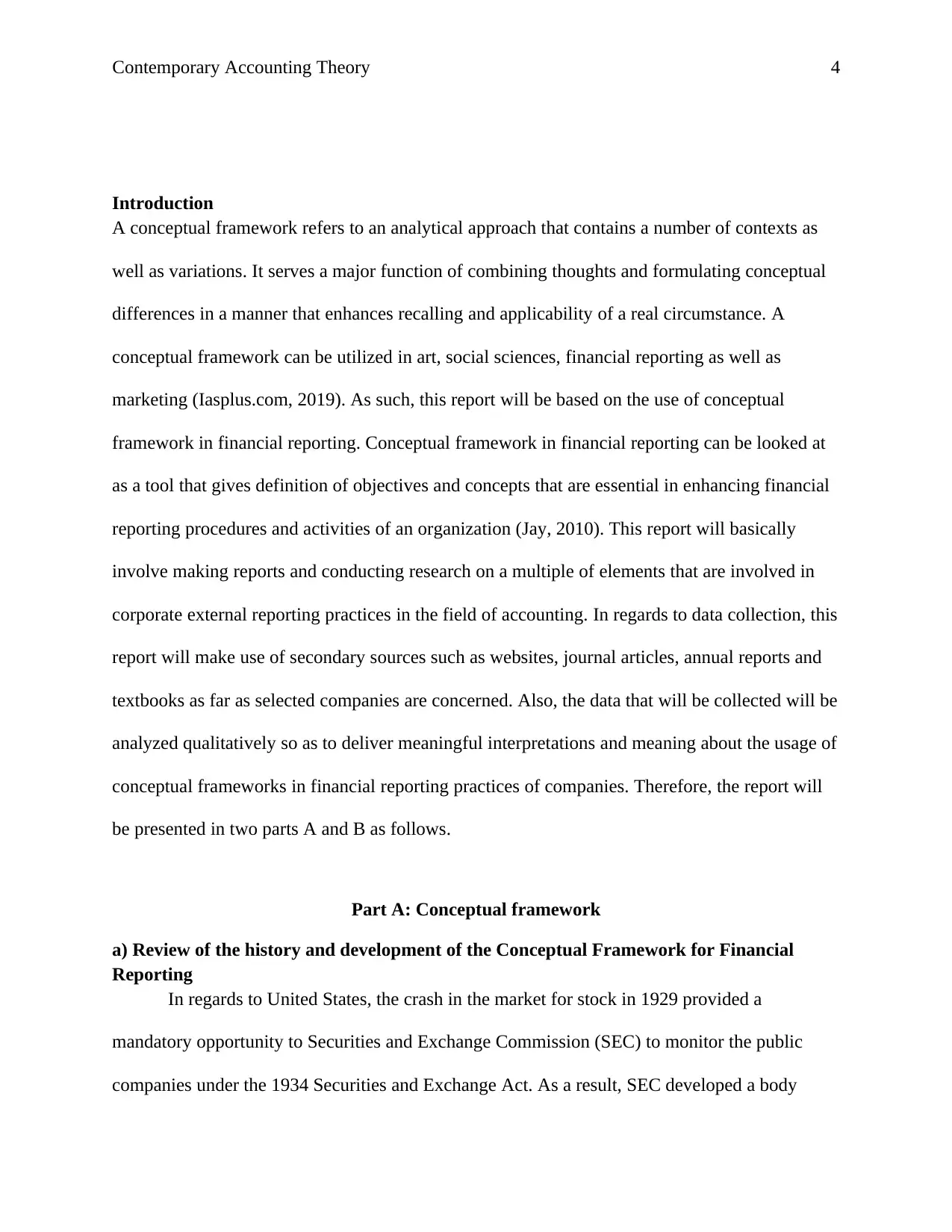
Contemporary Accounting Theory 4
Introduction
A conceptual framework refers to an analytical approach that contains a number of contexts as
well as variations. It serves a major function of combining thoughts and formulating conceptual
differences in a manner that enhances recalling and applicability of a real circumstance. A
conceptual framework can be utilized in art, social sciences, financial reporting as well as
marketing (Iasplus.com, 2019). As such, this report will be based on the use of conceptual
framework in financial reporting. Conceptual framework in financial reporting can be looked at
as a tool that gives definition of objectives and concepts that are essential in enhancing financial
reporting procedures and activities of an organization (Jay, 2010). This report will basically
involve making reports and conducting research on a multiple of elements that are involved in
corporate external reporting practices in the field of accounting. In regards to data collection, this
report will make use of secondary sources such as websites, journal articles, annual reports and
textbooks as far as selected companies are concerned. Also, the data that will be collected will be
analyzed qualitatively so as to deliver meaningful interpretations and meaning about the usage of
conceptual frameworks in financial reporting practices of companies. Therefore, the report will
be presented in two parts A and B as follows.
Part A: Conceptual framework
a) Review of the history and development of the Conceptual Framework for Financial
Reporting
In regards to United States, the crash in the market for stock in 1929 provided a
mandatory opportunity to Securities and Exchange Commission (SEC) to monitor the public
companies under the 1934 Securities and Exchange Act. As a result, SEC developed a body
Introduction
A conceptual framework refers to an analytical approach that contains a number of contexts as
well as variations. It serves a major function of combining thoughts and formulating conceptual
differences in a manner that enhances recalling and applicability of a real circumstance. A
conceptual framework can be utilized in art, social sciences, financial reporting as well as
marketing (Iasplus.com, 2019). As such, this report will be based on the use of conceptual
framework in financial reporting. Conceptual framework in financial reporting can be looked at
as a tool that gives definition of objectives and concepts that are essential in enhancing financial
reporting procedures and activities of an organization (Jay, 2010). This report will basically
involve making reports and conducting research on a multiple of elements that are involved in
corporate external reporting practices in the field of accounting. In regards to data collection, this
report will make use of secondary sources such as websites, journal articles, annual reports and
textbooks as far as selected companies are concerned. Also, the data that will be collected will be
analyzed qualitatively so as to deliver meaningful interpretations and meaning about the usage of
conceptual frameworks in financial reporting practices of companies. Therefore, the report will
be presented in two parts A and B as follows.
Part A: Conceptual framework
a) Review of the history and development of the Conceptual Framework for Financial
Reporting
In regards to United States, the crash in the market for stock in 1929 provided a
mandatory opportunity to Securities and Exchange Commission (SEC) to monitor the public
companies under the 1934 Securities and Exchange Act. As a result, SEC developed a body
Paraphrase This Document
Need a fresh take? Get an instant paraphrase of this document with our AI Paraphraser
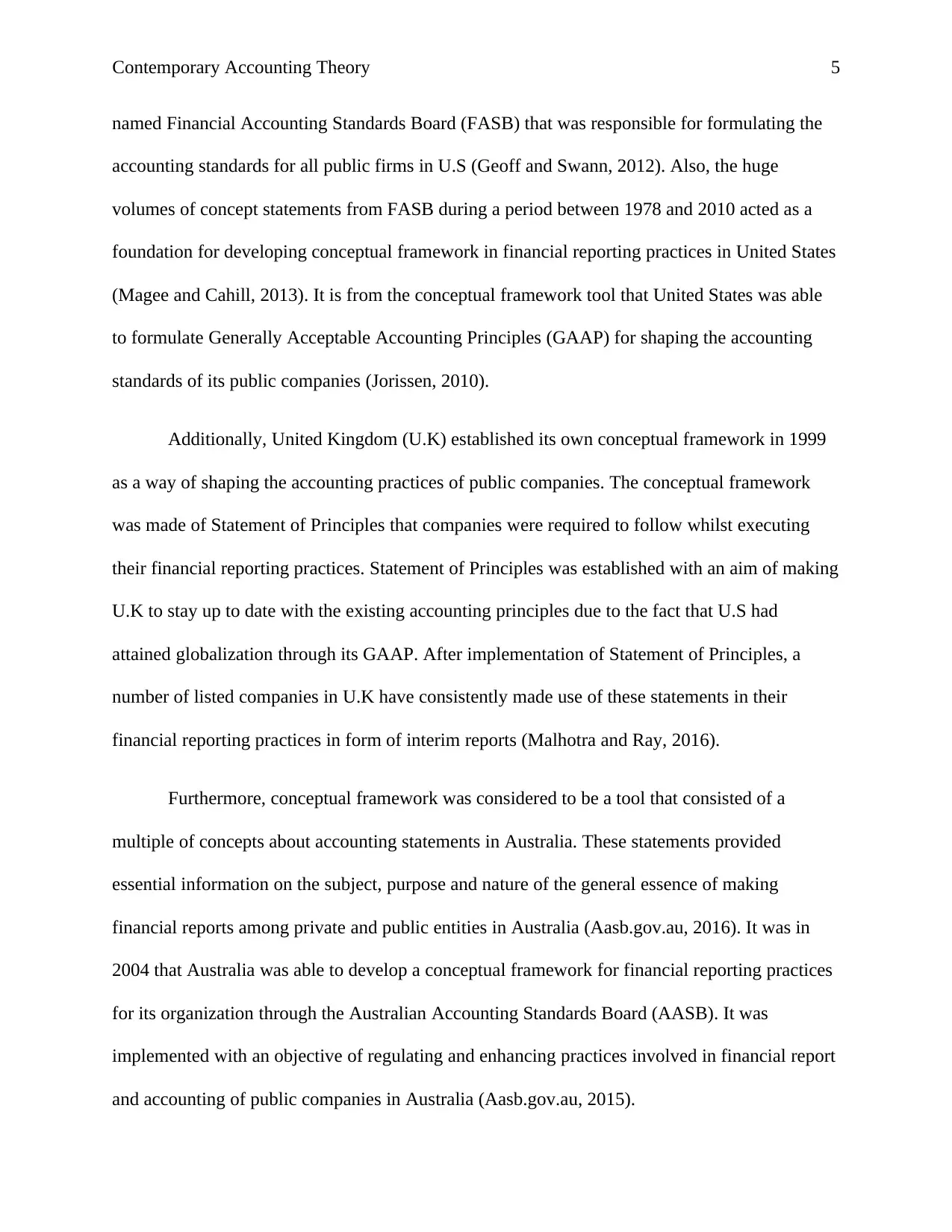
Contemporary Accounting Theory 5
named Financial Accounting Standards Board (FASB) that was responsible for formulating the
accounting standards for all public firms in U.S (Geoff and Swann, 2012). Also, the huge
volumes of concept statements from FASB during a period between 1978 and 2010 acted as a
foundation for developing conceptual framework in financial reporting practices in United States
(Magee and Cahill, 2013). It is from the conceptual framework tool that United States was able
to formulate Generally Acceptable Accounting Principles (GAAP) for shaping the accounting
standards of its public companies (Jorissen, 2010).
Additionally, United Kingdom (U.K) established its own conceptual framework in 1999
as a way of shaping the accounting practices of public companies. The conceptual framework
was made of Statement of Principles that companies were required to follow whilst executing
their financial reporting practices. Statement of Principles was established with an aim of making
U.K to stay up to date with the existing accounting principles due to the fact that U.S had
attained globalization through its GAAP. After implementation of Statement of Principles, a
number of listed companies in U.K have consistently made use of these statements in their
financial reporting practices in form of interim reports (Malhotra and Ray, 2016).
Furthermore, conceptual framework was considered to be a tool that consisted of a
multiple of concepts about accounting statements in Australia. These statements provided
essential information on the subject, purpose and nature of the general essence of making
financial reports among private and public entities in Australia (Aasb.gov.au, 2016). It was in
2004 that Australia was able to develop a conceptual framework for financial reporting practices
for its organization through the Australian Accounting Standards Board (AASB). It was
implemented with an objective of regulating and enhancing practices involved in financial report
and accounting of public companies in Australia (Aasb.gov.au, 2015).
named Financial Accounting Standards Board (FASB) that was responsible for formulating the
accounting standards for all public firms in U.S (Geoff and Swann, 2012). Also, the huge
volumes of concept statements from FASB during a period between 1978 and 2010 acted as a
foundation for developing conceptual framework in financial reporting practices in United States
(Magee and Cahill, 2013). It is from the conceptual framework tool that United States was able
to formulate Generally Acceptable Accounting Principles (GAAP) for shaping the accounting
standards of its public companies (Jorissen, 2010).
Additionally, United Kingdom (U.K) established its own conceptual framework in 1999
as a way of shaping the accounting practices of public companies. The conceptual framework
was made of Statement of Principles that companies were required to follow whilst executing
their financial reporting practices. Statement of Principles was established with an aim of making
U.K to stay up to date with the existing accounting principles due to the fact that U.S had
attained globalization through its GAAP. After implementation of Statement of Principles, a
number of listed companies in U.K have consistently made use of these statements in their
financial reporting practices in form of interim reports (Malhotra and Ray, 2016).
Furthermore, conceptual framework was considered to be a tool that consisted of a
multiple of concepts about accounting statements in Australia. These statements provided
essential information on the subject, purpose and nature of the general essence of making
financial reports among private and public entities in Australia (Aasb.gov.au, 2016). It was in
2004 that Australia was able to develop a conceptual framework for financial reporting practices
for its organization through the Australian Accounting Standards Board (AASB). It was
implemented with an objective of regulating and enhancing practices involved in financial report
and accounting of public companies in Australia (Aasb.gov.au, 2015).
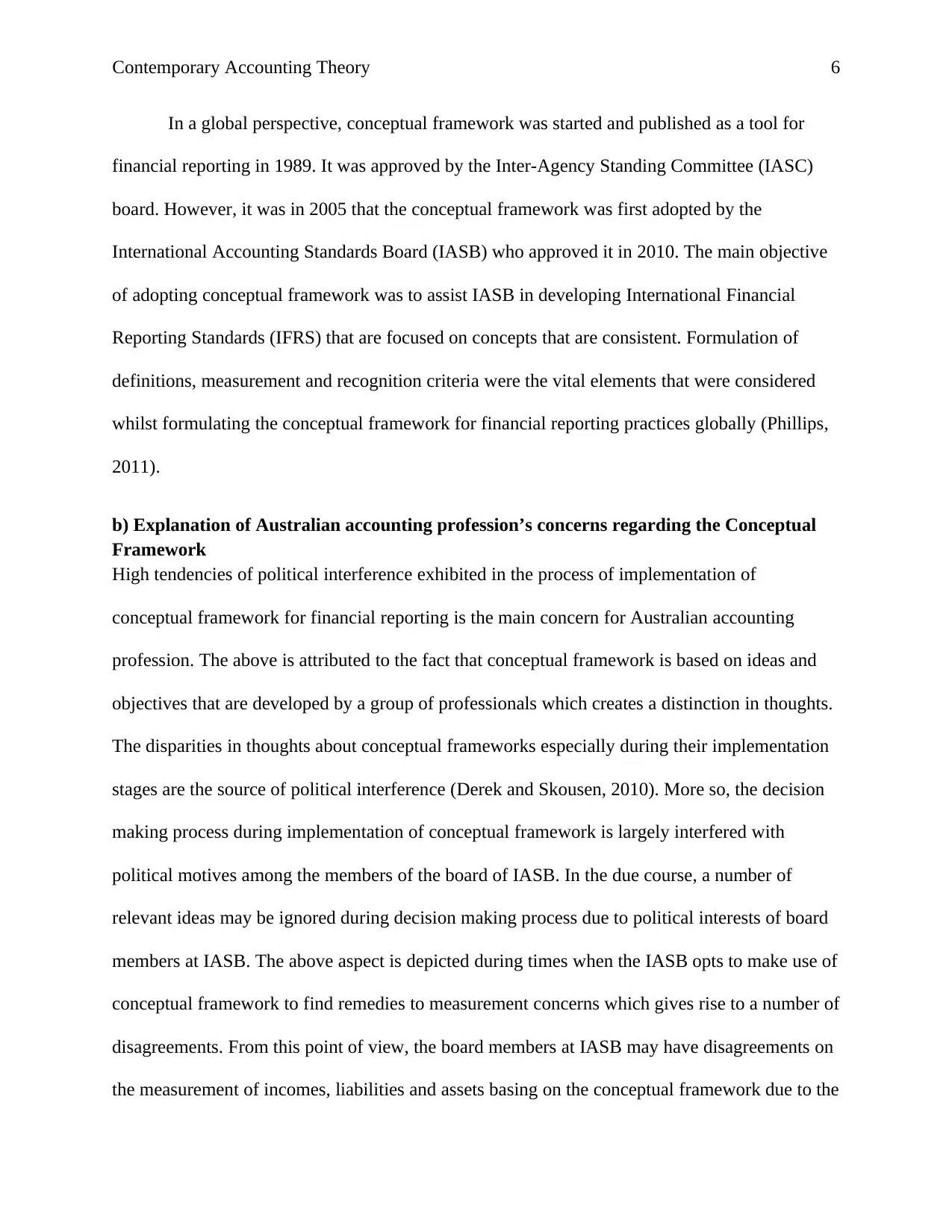
Contemporary Accounting Theory 6
In a global perspective, conceptual framework was started and published as a tool for
financial reporting in 1989. It was approved by the Inter-Agency Standing Committee (IASC)
board. However, it was in 2005 that the conceptual framework was first adopted by the
International Accounting Standards Board (IASB) who approved it in 2010. The main objective
of adopting conceptual framework was to assist IASB in developing International Financial
Reporting Standards (IFRS) that are focused on concepts that are consistent. Formulation of
definitions, measurement and recognition criteria were the vital elements that were considered
whilst formulating the conceptual framework for financial reporting practices globally (Phillips,
2011).
b) Explanation of Australian accounting profession’s concerns regarding the Conceptual
Framework
High tendencies of political interference exhibited in the process of implementation of
conceptual framework for financial reporting is the main concern for Australian accounting
profession. The above is attributed to the fact that conceptual framework is based on ideas and
objectives that are developed by a group of professionals which creates a distinction in thoughts.
The disparities in thoughts about conceptual frameworks especially during their implementation
stages are the source of political interference (Derek and Skousen, 2010). More so, the decision
making process during implementation of conceptual framework is largely interfered with
political motives among the members of the board of IASB. In the due course, a number of
relevant ideas may be ignored during decision making process due to political interests of board
members at IASB. The above aspect is depicted during times when the IASB opts to make use of
conceptual framework to find remedies to measurement concerns which gives rise to a number of
disagreements. From this point of view, the board members at IASB may have disagreements on
the measurement of incomes, liabilities and assets basing on the conceptual framework due to the
In a global perspective, conceptual framework was started and published as a tool for
financial reporting in 1989. It was approved by the Inter-Agency Standing Committee (IASC)
board. However, it was in 2005 that the conceptual framework was first adopted by the
International Accounting Standards Board (IASB) who approved it in 2010. The main objective
of adopting conceptual framework was to assist IASB in developing International Financial
Reporting Standards (IFRS) that are focused on concepts that are consistent. Formulation of
definitions, measurement and recognition criteria were the vital elements that were considered
whilst formulating the conceptual framework for financial reporting practices globally (Phillips,
2011).
b) Explanation of Australian accounting profession’s concerns regarding the Conceptual
Framework
High tendencies of political interference exhibited in the process of implementation of
conceptual framework for financial reporting is the main concern for Australian accounting
profession. The above is attributed to the fact that conceptual framework is based on ideas and
objectives that are developed by a group of professionals which creates a distinction in thoughts.
The disparities in thoughts about conceptual frameworks especially during their implementation
stages are the source of political interference (Derek and Skousen, 2010). More so, the decision
making process during implementation of conceptual framework is largely interfered with
political motives among the members of the board of IASB. In the due course, a number of
relevant ideas may be ignored during decision making process due to political interests of board
members at IASB. The above aspect is depicted during times when the IASB opts to make use of
conceptual framework to find remedies to measurement concerns which gives rise to a number of
disagreements. From this point of view, the board members at IASB may have disagreements on
the measurement of incomes, liabilities and assets basing on the conceptual framework due to the
⊘ This is a preview!⊘
Do you want full access?
Subscribe today to unlock all pages.

Trusted by 1+ million students worldwide

Contemporary Accounting Theory 7
ever changing economic condition in Australia (Charles and George, 2012). As a result, board
members may have varying thoughts on historical costs or present values of assets per say
because of the varying political interests. It can be seen that political interests increase on the
possibility of excluding relevant thoughts that would significantly contribute to formulation of
conceptual frameworks that would form more consistent accounting standards for delivering
reliable and accurate financial reports (Riggan, 2012). Therefore, members may continuously
have disparities in ideology about how assets, liabilities or incomes can be measured to ensure
that conceptual frameworks are consistent with the financial reporting principles.
c) Discussion of academics’ concerns about the quality (potential benefits and limitations)
of the Conceptual Framework
Conceptual framework is a tool that is associated with benefits as well as limitations which have
caused concerns among the academicians due to the fact that it is utilized by organizations when
they engage in financial reporting practices. Below is the discussion of the potential benefits
associated with the use of conceptual framework in financial reporting; Conceptual framework
act as a guiding tool to developers of standards of accounting so as to ensure that recognition and
measurement criteria for elements of financial statements are consistently determined (Riggan,
2012). Furthermore, conceptual framework facilitates discussions concerning accounting
challenges due to the fact that it acts as a guideline to developers of accounting standards.
Incidences of false recording of financial and business transactions in financial statements can be
identified and addressed by the formulators of accounting standards when they make use of
conceptual framework (Derek and Skousen, 2010). From the above discussion, it can be seen
that conceptual framework play a pivotal role in ensuring that consistent standards of accounting
are implemented to improve on the financial reporting practices of organizations.
ever changing economic condition in Australia (Charles and George, 2012). As a result, board
members may have varying thoughts on historical costs or present values of assets per say
because of the varying political interests. It can be seen that political interests increase on the
possibility of excluding relevant thoughts that would significantly contribute to formulation of
conceptual frameworks that would form more consistent accounting standards for delivering
reliable and accurate financial reports (Riggan, 2012). Therefore, members may continuously
have disparities in ideology about how assets, liabilities or incomes can be measured to ensure
that conceptual frameworks are consistent with the financial reporting principles.
c) Discussion of academics’ concerns about the quality (potential benefits and limitations)
of the Conceptual Framework
Conceptual framework is a tool that is associated with benefits as well as limitations which have
caused concerns among the academicians due to the fact that it is utilized by organizations when
they engage in financial reporting practices. Below is the discussion of the potential benefits
associated with the use of conceptual framework in financial reporting; Conceptual framework
act as a guiding tool to developers of standards of accounting so as to ensure that recognition and
measurement criteria for elements of financial statements are consistently determined (Riggan,
2012). Furthermore, conceptual framework facilitates discussions concerning accounting
challenges due to the fact that it acts as a guideline to developers of accounting standards.
Incidences of false recording of financial and business transactions in financial statements can be
identified and addressed by the formulators of accounting standards when they make use of
conceptual framework (Derek and Skousen, 2010). From the above discussion, it can be seen
that conceptual framework play a pivotal role in ensuring that consistent standards of accounting
are implemented to improve on the financial reporting practices of organizations.
Paraphrase This Document
Need a fresh take? Get an instant paraphrase of this document with our AI Paraphraser
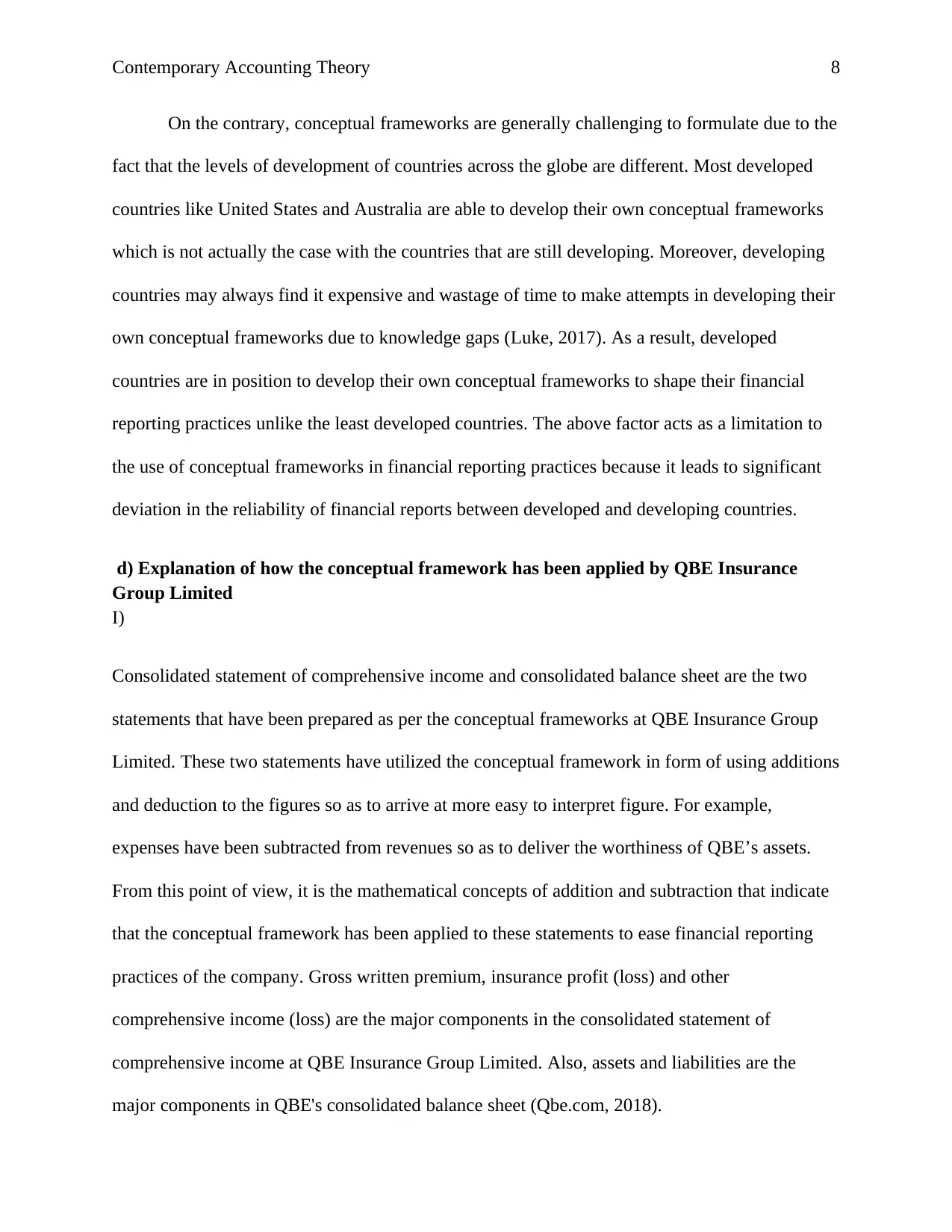
Contemporary Accounting Theory 8
On the contrary, conceptual frameworks are generally challenging to formulate due to the
fact that the levels of development of countries across the globe are different. Most developed
countries like United States and Australia are able to develop their own conceptual frameworks
which is not actually the case with the countries that are still developing. Moreover, developing
countries may always find it expensive and wastage of time to make attempts in developing their
own conceptual frameworks due to knowledge gaps (Luke, 2017). As a result, developed
countries are in position to develop their own conceptual frameworks to shape their financial
reporting practices unlike the least developed countries. The above factor acts as a limitation to
the use of conceptual frameworks in financial reporting practices because it leads to significant
deviation in the reliability of financial reports between developed and developing countries.
d) Explanation of how the conceptual framework has been applied by QBE Insurance
Group Limited
I)
Consolidated statement of comprehensive income and consolidated balance sheet are the two
statements that have been prepared as per the conceptual frameworks at QBE Insurance Group
Limited. These two statements have utilized the conceptual framework in form of using additions
and deduction to the figures so as to arrive at more easy to interpret figure. For example,
expenses have been subtracted from revenues so as to deliver the worthiness of QBE’s assets.
From this point of view, it is the mathematical concepts of addition and subtraction that indicate
that the conceptual framework has been applied to these statements to ease financial reporting
practices of the company. Gross written premium, insurance profit (loss) and other
comprehensive income (loss) are the major components in the consolidated statement of
comprehensive income at QBE Insurance Group Limited. Also, assets and liabilities are the
major components in QBE's consolidated balance sheet (Qbe.com, 2018).
On the contrary, conceptual frameworks are generally challenging to formulate due to the
fact that the levels of development of countries across the globe are different. Most developed
countries like United States and Australia are able to develop their own conceptual frameworks
which is not actually the case with the countries that are still developing. Moreover, developing
countries may always find it expensive and wastage of time to make attempts in developing their
own conceptual frameworks due to knowledge gaps (Luke, 2017). As a result, developed
countries are in position to develop their own conceptual frameworks to shape their financial
reporting practices unlike the least developed countries. The above factor acts as a limitation to
the use of conceptual frameworks in financial reporting practices because it leads to significant
deviation in the reliability of financial reports between developed and developing countries.
d) Explanation of how the conceptual framework has been applied by QBE Insurance
Group Limited
I)
Consolidated statement of comprehensive income and consolidated balance sheet are the two
statements that have been prepared as per the conceptual frameworks at QBE Insurance Group
Limited. These two statements have utilized the conceptual framework in form of using additions
and deduction to the figures so as to arrive at more easy to interpret figure. For example,
expenses have been subtracted from revenues so as to deliver the worthiness of QBE’s assets.
From this point of view, it is the mathematical concepts of addition and subtraction that indicate
that the conceptual framework has been applied to these statements to ease financial reporting
practices of the company. Gross written premium, insurance profit (loss) and other
comprehensive income (loss) are the major components in the consolidated statement of
comprehensive income at QBE Insurance Group Limited. Also, assets and liabilities are the
major components in QBE's consolidated balance sheet (Qbe.com, 2018).
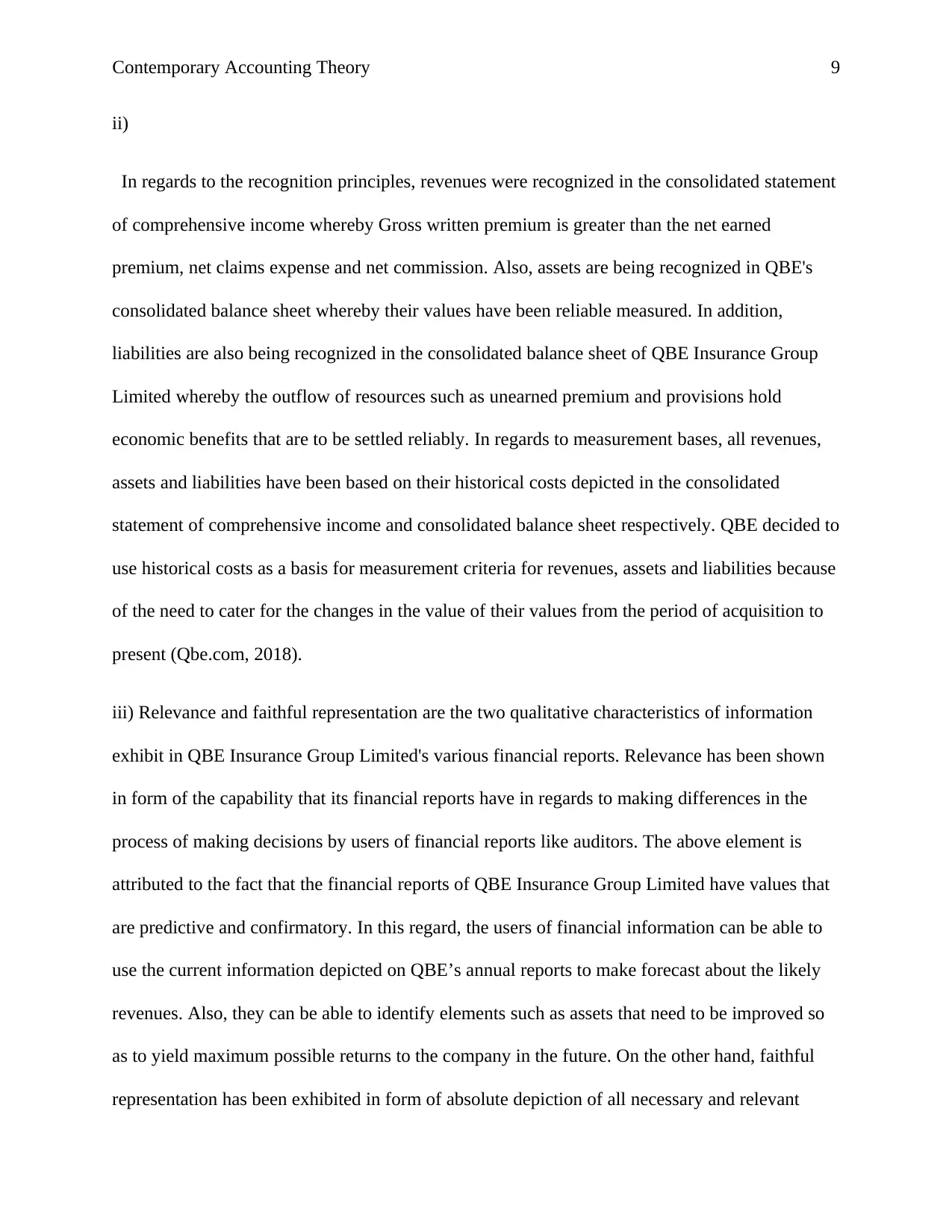
Contemporary Accounting Theory 9
ii)
In regards to the recognition principles, revenues were recognized in the consolidated statement
of comprehensive income whereby Gross written premium is greater than the net earned
premium, net claims expense and net commission. Also, assets are being recognized in QBE's
consolidated balance sheet whereby their values have been reliable measured. In addition,
liabilities are also being recognized in the consolidated balance sheet of QBE Insurance Group
Limited whereby the outflow of resources such as unearned premium and provisions hold
economic benefits that are to be settled reliably. In regards to measurement bases, all revenues,
assets and liabilities have been based on their historical costs depicted in the consolidated
statement of comprehensive income and consolidated balance sheet respectively. QBE decided to
use historical costs as a basis for measurement criteria for revenues, assets and liabilities because
of the need to cater for the changes in the value of their values from the period of acquisition to
present (Qbe.com, 2018).
iii) Relevance and faithful representation are the two qualitative characteristics of information
exhibit in QBE Insurance Group Limited's various financial reports. Relevance has been shown
in form of the capability that its financial reports have in regards to making differences in the
process of making decisions by users of financial reports like auditors. The above element is
attributed to the fact that the financial reports of QBE Insurance Group Limited have values that
are predictive and confirmatory. In this regard, the users of financial information can be able to
use the current information depicted on QBE’s annual reports to make forecast about the likely
revenues. Also, they can be able to identify elements such as assets that need to be improved so
as to yield maximum possible returns to the company in the future. On the other hand, faithful
representation has been exhibited in form of absolute depiction of all necessary and relevant
ii)
In regards to the recognition principles, revenues were recognized in the consolidated statement
of comprehensive income whereby Gross written premium is greater than the net earned
premium, net claims expense and net commission. Also, assets are being recognized in QBE's
consolidated balance sheet whereby their values have been reliable measured. In addition,
liabilities are also being recognized in the consolidated balance sheet of QBE Insurance Group
Limited whereby the outflow of resources such as unearned premium and provisions hold
economic benefits that are to be settled reliably. In regards to measurement bases, all revenues,
assets and liabilities have been based on their historical costs depicted in the consolidated
statement of comprehensive income and consolidated balance sheet respectively. QBE decided to
use historical costs as a basis for measurement criteria for revenues, assets and liabilities because
of the need to cater for the changes in the value of their values from the period of acquisition to
present (Qbe.com, 2018).
iii) Relevance and faithful representation are the two qualitative characteristics of information
exhibit in QBE Insurance Group Limited's various financial reports. Relevance has been shown
in form of the capability that its financial reports have in regards to making differences in the
process of making decisions by users of financial reports like auditors. The above element is
attributed to the fact that the financial reports of QBE Insurance Group Limited have values that
are predictive and confirmatory. In this regard, the users of financial information can be able to
use the current information depicted on QBE’s annual reports to make forecast about the likely
revenues. Also, they can be able to identify elements such as assets that need to be improved so
as to yield maximum possible returns to the company in the future. On the other hand, faithful
representation has been exhibited in form of absolute depiction of all necessary and relevant
⊘ This is a preview!⊘
Do you want full access?
Subscribe today to unlock all pages.

Trusted by 1+ million students worldwide
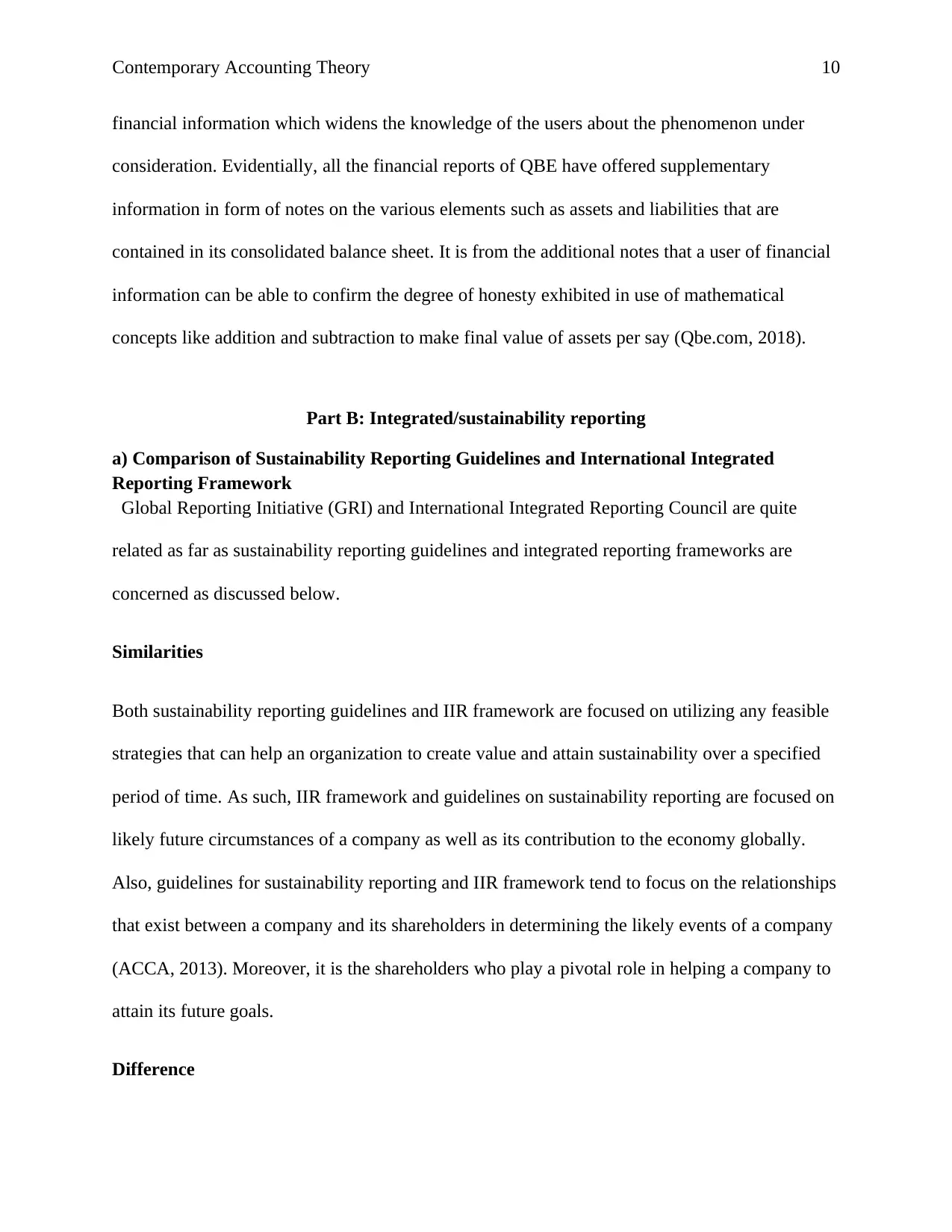
Contemporary Accounting Theory 10
financial information which widens the knowledge of the users about the phenomenon under
consideration. Evidentially, all the financial reports of QBE have offered supplementary
information in form of notes on the various elements such as assets and liabilities that are
contained in its consolidated balance sheet. It is from the additional notes that a user of financial
information can be able to confirm the degree of honesty exhibited in use of mathematical
concepts like addition and subtraction to make final value of assets per say (Qbe.com, 2018).
Part B: Integrated/sustainability reporting
a) Comparison of Sustainability Reporting Guidelines and International Integrated
Reporting Framework
Global Reporting Initiative (GRI) and International Integrated Reporting Council are quite
related as far as sustainability reporting guidelines and integrated reporting frameworks are
concerned as discussed below.
Similarities
Both sustainability reporting guidelines and IIR framework are focused on utilizing any feasible
strategies that can help an organization to create value and attain sustainability over a specified
period of time. As such, IIR framework and guidelines on sustainability reporting are focused on
likely future circumstances of a company as well as its contribution to the economy globally.
Also, guidelines for sustainability reporting and IIR framework tend to focus on the relationships
that exist between a company and its shareholders in determining the likely events of a company
(ACCA, 2013). Moreover, it is the shareholders who play a pivotal role in helping a company to
attain its future goals.
Difference
financial information which widens the knowledge of the users about the phenomenon under
consideration. Evidentially, all the financial reports of QBE have offered supplementary
information in form of notes on the various elements such as assets and liabilities that are
contained in its consolidated balance sheet. It is from the additional notes that a user of financial
information can be able to confirm the degree of honesty exhibited in use of mathematical
concepts like addition and subtraction to make final value of assets per say (Qbe.com, 2018).
Part B: Integrated/sustainability reporting
a) Comparison of Sustainability Reporting Guidelines and International Integrated
Reporting Framework
Global Reporting Initiative (GRI) and International Integrated Reporting Council are quite
related as far as sustainability reporting guidelines and integrated reporting frameworks are
concerned as discussed below.
Similarities
Both sustainability reporting guidelines and IIR framework are focused on utilizing any feasible
strategies that can help an organization to create value and attain sustainability over a specified
period of time. As such, IIR framework and guidelines on sustainability reporting are focused on
likely future circumstances of a company as well as its contribution to the economy globally.
Also, guidelines for sustainability reporting and IIR framework tend to focus on the relationships
that exist between a company and its shareholders in determining the likely events of a company
(ACCA, 2013). Moreover, it is the shareholders who play a pivotal role in helping a company to
attain its future goals.
Difference
Paraphrase This Document
Need a fresh take? Get an instant paraphrase of this document with our AI Paraphraser
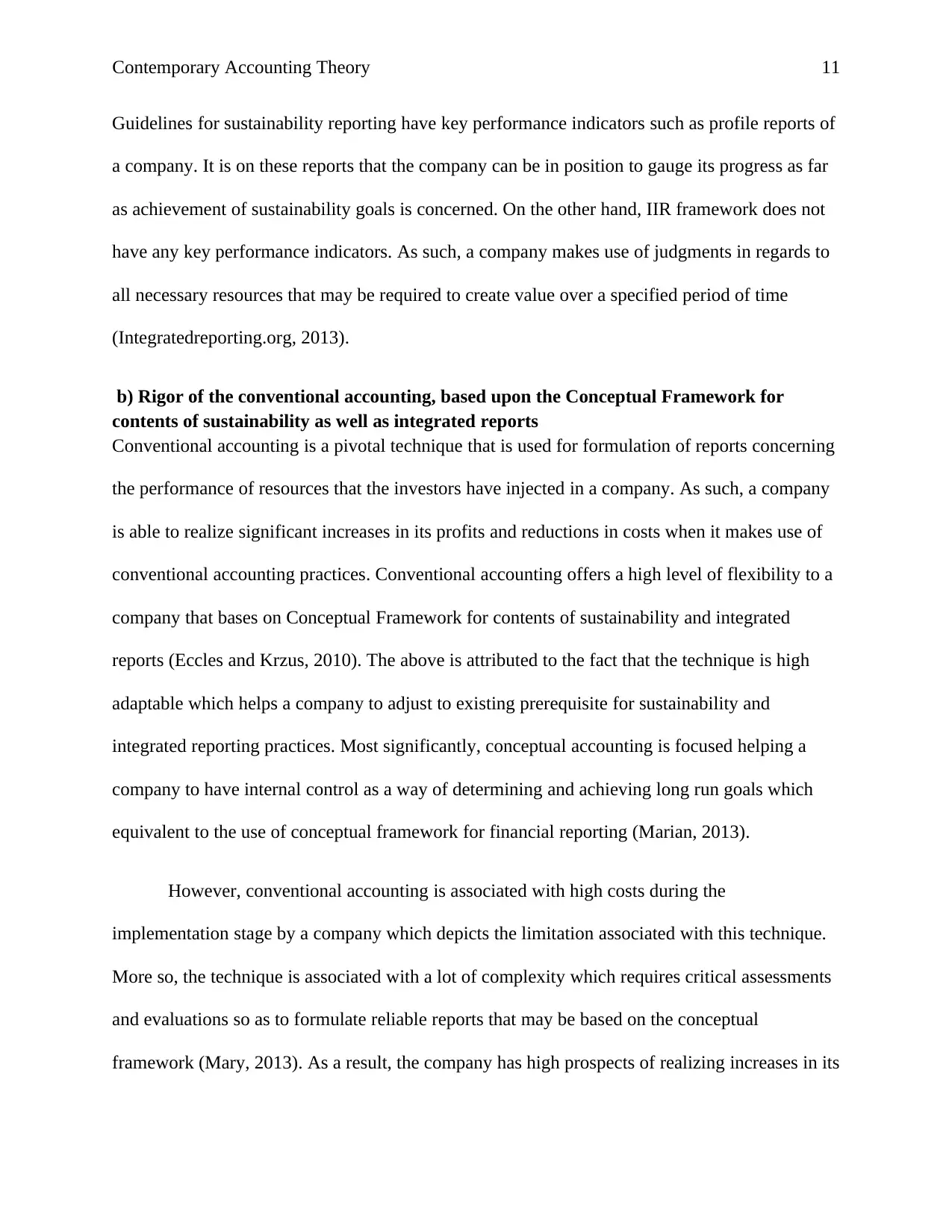
Contemporary Accounting Theory 11
Guidelines for sustainability reporting have key performance indicators such as profile reports of
a company. It is on these reports that the company can be in position to gauge its progress as far
as achievement of sustainability goals is concerned. On the other hand, IIR framework does not
have any key performance indicators. As such, a company makes use of judgments in regards to
all necessary resources that may be required to create value over a specified period of time
(Integratedreporting.org, 2013).
b) Rigor of the conventional accounting, based upon the Conceptual Framework for
contents of sustainability as well as integrated reports
Conventional accounting is a pivotal technique that is used for formulation of reports concerning
the performance of resources that the investors have injected in a company. As such, a company
is able to realize significant increases in its profits and reductions in costs when it makes use of
conventional accounting practices. Conventional accounting offers a high level of flexibility to a
company that bases on Conceptual Framework for contents of sustainability and integrated
reports (Eccles and Krzus, 2010). The above is attributed to the fact that the technique is high
adaptable which helps a company to adjust to existing prerequisite for sustainability and
integrated reporting practices. Most significantly, conceptual accounting is focused helping a
company to have internal control as a way of determining and achieving long run goals which
equivalent to the use of conceptual framework for financial reporting (Marian, 2013).
However, conventional accounting is associated with high costs during the
implementation stage by a company which depicts the limitation associated with this technique.
More so, the technique is associated with a lot of complexity which requires critical assessments
and evaluations so as to formulate reliable reports that may be based on the conceptual
framework (Mary, 2013). As a result, the company has high prospects of realizing increases in its
Guidelines for sustainability reporting have key performance indicators such as profile reports of
a company. It is on these reports that the company can be in position to gauge its progress as far
as achievement of sustainability goals is concerned. On the other hand, IIR framework does not
have any key performance indicators. As such, a company makes use of judgments in regards to
all necessary resources that may be required to create value over a specified period of time
(Integratedreporting.org, 2013).
b) Rigor of the conventional accounting, based upon the Conceptual Framework for
contents of sustainability as well as integrated reports
Conventional accounting is a pivotal technique that is used for formulation of reports concerning
the performance of resources that the investors have injected in a company. As such, a company
is able to realize significant increases in its profits and reductions in costs when it makes use of
conventional accounting practices. Conventional accounting offers a high level of flexibility to a
company that bases on Conceptual Framework for contents of sustainability and integrated
reports (Eccles and Krzus, 2010). The above is attributed to the fact that the technique is high
adaptable which helps a company to adjust to existing prerequisite for sustainability and
integrated reporting practices. Most significantly, conceptual accounting is focused helping a
company to have internal control as a way of determining and achieving long run goals which
equivalent to the use of conceptual framework for financial reporting (Marian, 2013).
However, conventional accounting is associated with high costs during the
implementation stage by a company which depicts the limitation associated with this technique.
More so, the technique is associated with a lot of complexity which requires critical assessments
and evaluations so as to formulate reliable reports that may be based on the conceptual
framework (Mary, 2013). As a result, the company has high prospects of realizing increases in its
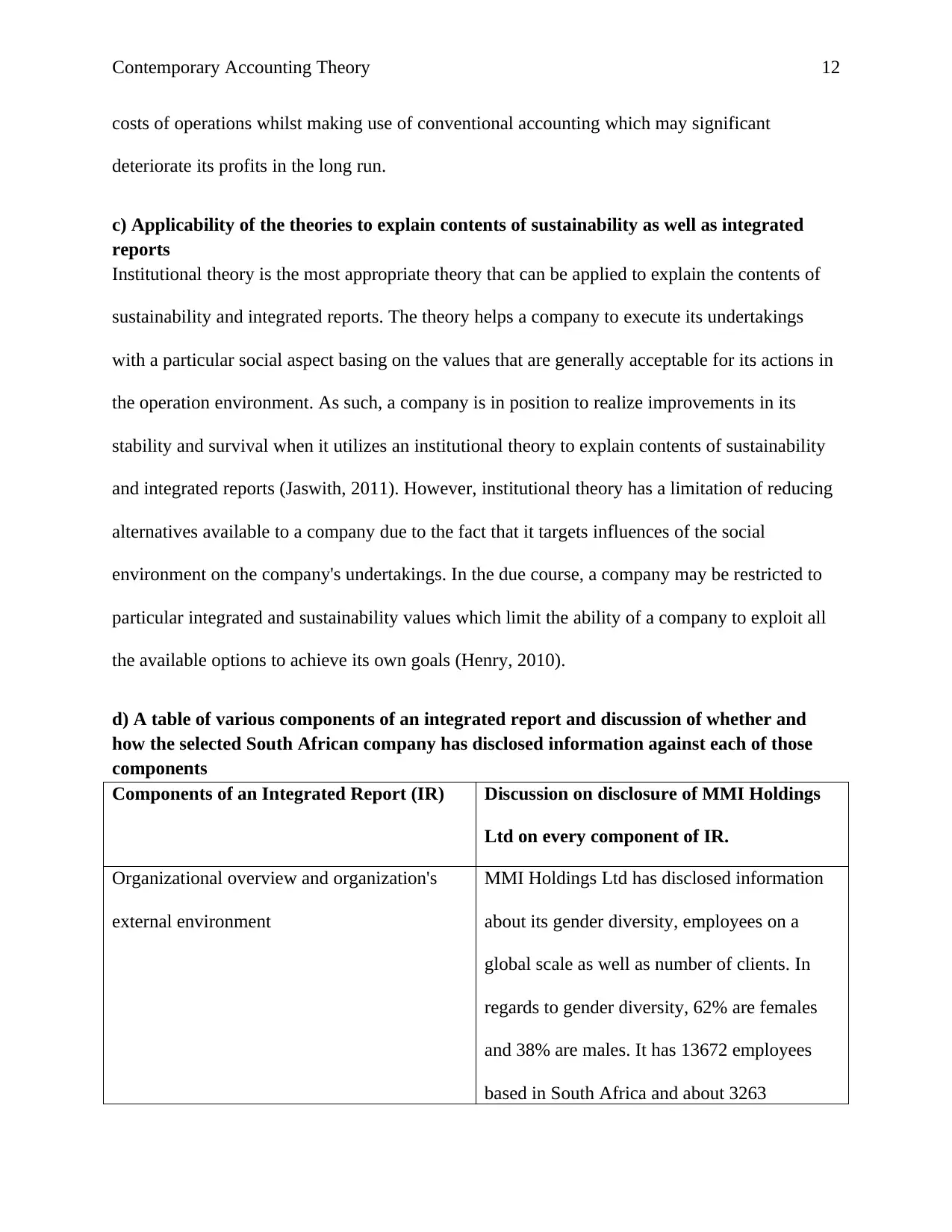
Contemporary Accounting Theory 12
costs of operations whilst making use of conventional accounting which may significant
deteriorate its profits in the long run.
c) Applicability of the theories to explain contents of sustainability as well as integrated
reports
Institutional theory is the most appropriate theory that can be applied to explain the contents of
sustainability and integrated reports. The theory helps a company to execute its undertakings
with a particular social aspect basing on the values that are generally acceptable for its actions in
the operation environment. As such, a company is in position to realize improvements in its
stability and survival when it utilizes an institutional theory to explain contents of sustainability
and integrated reports (Jaswith, 2011). However, institutional theory has a limitation of reducing
alternatives available to a company due to the fact that it targets influences of the social
environment on the company's undertakings. In the due course, a company may be restricted to
particular integrated and sustainability values which limit the ability of a company to exploit all
the available options to achieve its own goals (Henry, 2010).
d) A table of various components of an integrated report and discussion of whether and
how the selected South African company has disclosed information against each of those
components
Components of an Integrated Report (IR) Discussion on disclosure of MMI Holdings
Ltd on every component of IR.
Organizational overview and organization's
external environment
MMI Holdings Ltd has disclosed information
about its gender diversity, employees on a
global scale as well as number of clients. In
regards to gender diversity, 62% are females
and 38% are males. It has 13672 employees
based in South Africa and about 3263
costs of operations whilst making use of conventional accounting which may significant
deteriorate its profits in the long run.
c) Applicability of the theories to explain contents of sustainability as well as integrated
reports
Institutional theory is the most appropriate theory that can be applied to explain the contents of
sustainability and integrated reports. The theory helps a company to execute its undertakings
with a particular social aspect basing on the values that are generally acceptable for its actions in
the operation environment. As such, a company is in position to realize improvements in its
stability and survival when it utilizes an institutional theory to explain contents of sustainability
and integrated reports (Jaswith, 2011). However, institutional theory has a limitation of reducing
alternatives available to a company due to the fact that it targets influences of the social
environment on the company's undertakings. In the due course, a company may be restricted to
particular integrated and sustainability values which limit the ability of a company to exploit all
the available options to achieve its own goals (Henry, 2010).
d) A table of various components of an integrated report and discussion of whether and
how the selected South African company has disclosed information against each of those
components
Components of an Integrated Report (IR) Discussion on disclosure of MMI Holdings
Ltd on every component of IR.
Organizational overview and organization's
external environment
MMI Holdings Ltd has disclosed information
about its gender diversity, employees on a
global scale as well as number of clients. In
regards to gender diversity, 62% are females
and 38% are males. It has 13672 employees
based in South Africa and about 3263
⊘ This is a preview!⊘
Do you want full access?
Subscribe today to unlock all pages.

Trusted by 1+ million students worldwide
1 out of 18
Related Documents
Your All-in-One AI-Powered Toolkit for Academic Success.
+13062052269
info@desklib.com
Available 24*7 on WhatsApp / Email
![[object Object]](/_next/static/media/star-bottom.7253800d.svg)
Unlock your academic potential
Copyright © 2020–2025 A2Z Services. All Rights Reserved. Developed and managed by ZUCOL.





